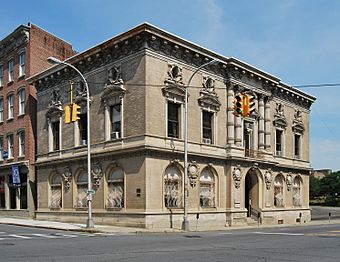United Traction Company Building facts for kids
Quick facts for kids |
|
|
United Traction Company Building
|
|
|
U.S. Historic district
Contributing property |
|

South profile and east elevation, 2011
|
|
| Location | Albany, New York |
|---|---|
| Area | 1.1 acres (4,500 m2) |
| Built | 1899 |
| Architect | Marcus T. Reynolds |
| Architectural style | Renaissance |
| Part of | Downtown Albany Historic District |
| NRHP reference No. | 76001205 |
| Added to NRHP | May 24, 1976 |
The United Traction Company Building is a historic building in Albany, New York. It stands on Broadway, a main street in the city. A local architect named Marcus T. Reynolds designed it. The building was finished in the late 1800s.
It has a special look called Renaissance Revival style. This style was popular at the time. In 1976, the building was added to the National Register of Historic Places. This means it's an important historical site. Later, it became part of the Downtown Albany Historic District.
This building used to be the main office for the United Traction Company. This company ran the city's trolley system. Trolleys are like electric buses that run on tracks. The building's design matched the nearby Union Station. Both buildings welcomed visitors to Albany. The company later switched to buses. They stayed in the building until the 1950s. Today, other businesses use the building.
Contents
About the Building's Design
The United Traction Company Building sits on a corner lot. It is located at Broadway and Columbia Street. This area is a busy part of downtown Albany. There are other buildings and a park nearby. The land around it is mostly flat.
The building looks like a rectangle from the street. However, it is actually shaped like a trapezoid. It has two floors and a flat roof. The outside is covered in light brown bricks. Stone and special clay called terra cotta decorate the parts facing the streets.
Windows and Details
The windows on both sides are set back in arched openings. Each window has a fancy stone decoration above it. Large carved designs called cartouches are between the windows. A decorated strip runs below the roofline of the first floor. This strip is called a frieze.
The second floor looks more grand. Its windows are in rectangular openings. They have curved tops that look like small roofs. These are called segmental pediments. All the lower windows can slide up and down. At the very top, a decorated roof edge hangs out over the building.
Main Entrance
The main entrance is in the middle of the building. It sticks out a little bit. This entrance also has a rounded arch. Stone plaques below the steps say "United Traction Company." Above the entrance is a balcony. Two round, decorated columns stand next to the balcony. These columns have fancy tops.
Inside the Building
The inside of the building has changed over time. But some original parts are still there. The first floor has an oval-shaped main hall. It has a colorful marble floor and marble walls. An archway leads to stairs with marble steps. The stairs also have a fancy metal railing. Some rooms on the first floor still have their original stone walls and patterned floors. The rooms on the upper floors are simpler.
History of the Building
Early Trolley Days
Horse-drawn trolleys started running in Albany in 1864. The Albany Railway Company operated them. In 1890, they began using electric trolleys. By 1899, the company was doing very well. They asked Marcus T. Reynolds to design their new headquarters. Around the time they moved in, the company changed its name. It became the United Traction Company.
Reynolds' design for the building was inspired by old Italian palaces. It was a smaller, but equally grand, building. It stood near the large Union Station. Both buildings were important landmarks. They were often the first buildings visitors saw when they arrived in Albany.
Changes Over Time
Cars became very popular in the 1900s. This led to fewer people using trolleys. In the 1930s, United Traction started using buses instead of trolleys. The last trolley stopped running in 1946. The company stayed in the building until 1950.
Later, the company faced money problems. In the early 1970s, it joined other bus companies. They became part of a new public group. This group is called the Capital District Transportation Authority. The United Traction Company Building is now the only reminder of the old company.



